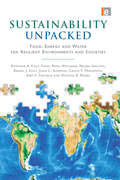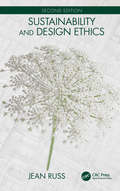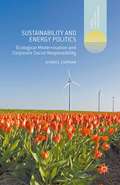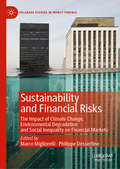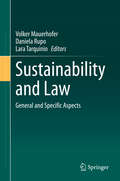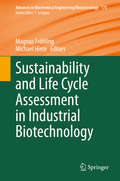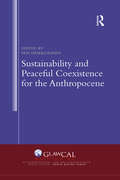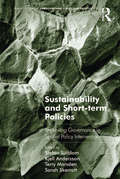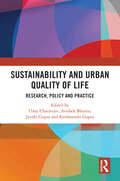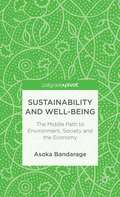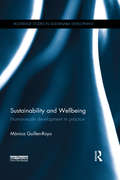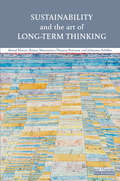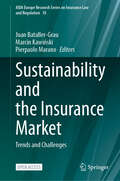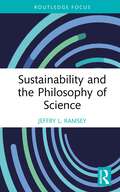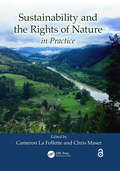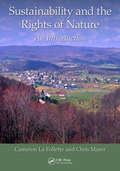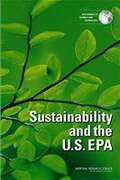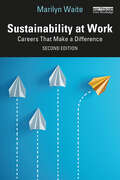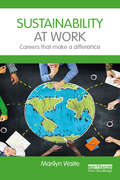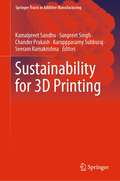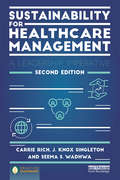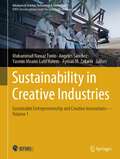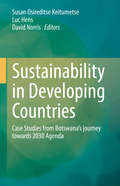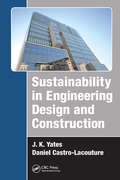- Table View
- List View
Sustainability Unpacked: Food, Energy and Water for Resilient Environments and Societies
by Toral Patel-Weynand Kristiina Vogt Maura Shelton Daniel J Vogt John C. Gordon Cal Mukumoto Asep. S. Suntana Patricia A. RoadsFood, water and energy form some of the basic elements of sustainability considerations. This ground-breaking book examines and decodes these elements, exploring how a range of countries make decisions regarding their energy and bio-resource consumption and procurement. The authors consider how these choices impact not only the societies and environments of those countries, but the world in general. To achieve this, the authors review the merits of various sustainability and environmental metrics, and then apply these to 34 countries that are ranked low, medium or high on the human development index. The book assesses their resource capacities and the environmental impacts, both within and outside their country boundaries, from consuming food, water, and energy. The final section uses the lessons derived from the earlier analyses of resource consumption to explore the importance of geography, climates and sustainable management of forests and other natural resources for building resilient societies in the future.
Sustainability and Design Ethics
by Jean Russ<p>Sustainability as a concept remains just as challenging and important today as it was when the first edition of this book was published. The Second Edition of Sustainability and Design Ethics explores the ethical obligations of knowledgeable people such as design professionals, taking into consideration the numerous changes that have taken place in recent years. This book expands the growing discussion on the principles of sustainability to further include the role of businesses and governments and considers the general recognition that modern society has occurred at the expense of nature with significant social and environmental impacts. <p>Are there limits to the individual’s ethical obligation? How do such obligations change or adapt to a world of sustainable design? As the shift toward sustainability proceeds, designers’ ethical underpinnings will be confronted with a wider range of people and concerns whose interests must be weighed. The design professionals are likely to be among the lead in the shift toward sustainability because of the special knowledge and expertise provided to them by their education, experience, and distinctive position in society. The entire world of design is being reassessed and the guiding principles and ethics of design reflect this change. <p>New to the Second Edition: <p> <li>Expanded international scope that includes a comparison of professional organizations in the EU, Australia, Canada, Japan and China <li>Discusses how cultural differences between the West and China result in different underlying foundations for professional ethics <li>Revised analyses to reflect changes in regulatory and technical areas such as the inevitable rise of artificial intelligence in design <li>Updated arguments reflecting the need for sustainability and the designer's role and obligations <li>Updated references pertaining to the progress of sustainable design and development</li> <p>Sustainability and Design Ethics, Second Edition is an attempt to explore the ideas and principles that might contribute to the thinking of thoughtful design professionals. The emergence of "green" design discussed in this book is used to evidence progress, but also to demonstrate the degree to which more is needed.</p>
Sustainability and Energy Politics: Ecological Modernisation and Corporate Social Responsibility (Energy, Climate and the Environment)
by Giorel CurranThe author explores the fraught politics of energy transitions in an age of climate change. She does so through an ecological modernisation and corporate social responsibility lens which she contends shapes and underpins sustainability today. Case studies cover climate policy, unconventional gas and renewable energy.
Sustainability and Financial Risks: The Impact of Climate Change, Environmental Degradation and Social Inequality on Financial Markets (Palgrave Studies in Impact Finance)
by Marco Migliorelli Philippe DessertineDespite growing discussions on the relationship between sustainability and finance, so far little attention has been given to the relation linking sustainability-related risks and financial risks. Climate change, environmental degradation and social inequality, among others factors, may indeed have considerable adverse impacts on financial actors and markets, and even have the potential to harm financial stability. Shedding light on the importance of the nexus between sustainability and financial risks, this book addresses the need for new industry and policy approaches. With insights from a skilled set of scholars in the finance field, this edited collection explores the effects of climate risks on the banking and insurance industries, the problem of stranded assets, the possible corporate risk management frameworks that could be used to control sustainability-related risks, the role of non-financial disclosure in fostering market discipline, and the policy actions needed to integrate sustainability considerations into prudential supervision. Tackling an interdisciplinary topic, this book will appeal to academics and practitioners within the finance, business and sustainability fields.
Sustainability and Law: General and Specific Aspects
by Volker Mauerhofer Daniela Rupo Lara TarquinioThe book discusses sustainability and law in a multifaceted way. Together, sustainability and law are an emerging challenge for research and science. This volume contributes through an interdisciplinary concept to its further exploration. The contributions explore this exciting domain with innovative ideas and replicable approaches. It combines a variety of authors, from both the public and the private sectors, and thereby guarantees a broad view that enshrines the more theoretical arguments from the academic side as well as stronger practical applicable perspectives. The book provides space for thoughtful expansions of established theories as well as the hopeful emergence of innovative ideas. Moreover, the combination of three to five contributions into the eleven parts respectively aims toward a compression of like minded thoughts. This should lead to an intensification of exchange of viewpoints from different angles on a similar theme. Readers therefore also have the opportunity to concentrate on single chapters, but receive comprised knowledge and a variety of thoughts for new ideas on a particular theme.
Sustainability and Life Cycle Assessment in Industrial Biotechnology (Advances in Biochemical Engineering/Biotechnology #173)
by Magnus Fröhling Michael HieteThis book reviews the assessment of industrial biotechnology products and processes from a sustainable perspective. Industrial Biotechnology is a comparably young field which comes along with high expectations with regard to sustainability issues. These stem from the promise of reducing greenhouse gas emissions and replacing fossil resources in the near or later future and using green technology, i.e. more environmentally friendly technologies. The intended economic, ecological and social benefits, however, need to be proven, resulting in a variety of challenges, both from a methodological and application point of view. In this book, specific assessment and application topics of industrial biotechnology are addressed, highlighting challenges and solutions for both developers and users of assessment methods. In twelve chapters, experts in their particular fields define the scope, characterize industrial biotechnology and show in their contributions the state of the art, challenges and prospects of assessing industrial biotechnology products and processes.The chapter 'Societal and Ethical Aspects of Industrial Biotechnology' of this book is available open access under a CC BY 4.0 license at link.springer.com
Sustainability and Peaceful Coexistence for the Anthropocene (Transnational Law and Governance)
by Pasi HeikkurinenThe rapid industrialization of societies has resulted in radical changes to the Earth’s biosphere and its local ecosystems. Climate scientists have recorded and forecasted worrying global temperature rises going back to the early twentieth century, while biologists and palaeontologists have suggested that the next mass extinction is on its way if the current rate of species loss continues. To avert further ecological damage, excessive natural resource use and environmental deterioration are challenges that humanity must deal with now. The human species has had such a significant impact on the natural environment that the present geological epoch can be referred to as the ‘Anthropocene’, the age of humans. The blame and responsibility for the prevailing unsustainability, however, cannot be assigned equally to all humans. To analyse the root problems and consequences of unsustainable development, as well as to outline rigorous solutions for the contemporary age, this transdisciplinary book brings together natural and social sciences under the rubric of the Anthropocene. The book identifies the central preconditions for social organization and governance to enable the peaceful coexistence of humans and the non-human world. The contributors investigate the burning questions of sustainability from a number of different perspectives including geosciences, economics, law, organizational studies, political theory and philosophy. The book is a state-of-the-art review of the Anthropocene debate and provides crucial signposts for how human activities can, and should, be changed.
Sustainability and Short-term Policies: Improving Governance in Spatial Policy Interventions (Routledge Studies in Environmental Policy and Practice)
by Kjell Andersson Stefan Sjöblom Sarah SkerrattThere has been a profound change within the sphere of government and societal regulation in recent years. Traditional hierarchical government has been challenged by new governance instruments relying on negotiations instead of command and control. Alongside this development there has been a change in the time-framing of politics and steering. Traditional politics implicitly has been based on stability and permanence while new forms of governance explicitly are based on just-in-time actions such as projects and issue-based collaborations in networks and programs. This book analyses the implications of this shortening of time frames, focusing particularly on spatial policy interventions. Spatial policies have a special relevance when it comes to governance and new forms of societal steering. On the one hand, the local (geographical) level in politics is the principal battleground for the struggle between top down and bottom up approaches and aspirations. On the other hand, many of the most burning issues of our time require a global, strategic approach, for example, climate change, resource depletion, population growth are anchored in space and the physical world. Whether and how short-term spatial approaches can achieve sustainable development outcomes is thus a critical question, and forms the focus of this volume. The book examines the characteristics of temporary policy measures across a range of rural, urban and regional contexts, in four continents: Europe, North America, Oceania and Africa. The outcomes and effects of these policies and interventions are analysed, particularly focusing on the tension between short-term interventions and long-term effects.
Sustainability and Urban Quality of Life: Research, Policy and Practice
by Uday Chatterjee, Avishek Bhunia, Jyothi Gupta and Krishnendu GuptaThis book conceptualizes and synthesizes worldwide research on the quality of urban life. It looks at quality of life within urban cities analysing amenities, infrastructure and assets while also bringing in the discourse around scarcity, disparity, accessibility, sustainability, equity, and well-being.Organized into four major parts, the book reflects on the interconnections between theories and practice and through a multi-disciplinary approach focuses on the aspects of urban environment and planning that makes cities inclusive, safe, resilient, smart, and sustainable. This book highlights the enormous strain on urban areas due to severe scarcity of civic systems and provides an in-depth look into urban concerns and pressing challenges from a global perspective, as well as many planning approaches to solving these problems.This book will be useful to students, researchers and teachers working in the field of urban studies, remote sensing and GIS, planning and sustainability, sustainable development, urban geography, development geography and population geography. This book would also be an invaluable companion to thought leaders, policy makers and industry and other professionals working in the field of urban planning and human development.
Sustainability and Well-Being: The Middle Path to Environment, Society, and the Economy
by Asoka BandarageA powerful social science analysis and a compassionate philosophical perspective to face the twin challenges of environmental sustainability and human well-being.
Sustainability and Wellbeing: Human-Scale Development in Practice (Routledge Studies in Sustainable Development)
by Mònica Guillen-RoyoThe idea that we can meet human needs and simultaneously conserve and even enhance the natural environment is an attractive one. Since the Brundtland report popularised a definition of sustainable development based on the concept of needs, there has been a widespread belief that it should be possible to achieve a good quality of life without compromising natural ecosystems. Sustainability and Wellbeing fills a gap in sustainable development studies by drawing on a range of case-studies to discuss the challenges and opportunities of using Max-Neef’s Human Scale Development (HSD) framework in practice. The first section presents the theory and the methodology of HSD in the context of related literature on sustainable development and wellbeing. The second section discusses applications of the HSD methodology with three different purposes: the design of sustainable development interventions; the engagement of researchers with communities or groups of people in sustainability processes and the consolidation of sustainable community initiatives. Finally, the third reflects on challenges and limitations of using the HSD approach to define strategies for sustainable development and concludes. This is an invaluable resource for researchers and postgraduate students in wellbeing, sustainability, sustainable development, and human development.
Sustainability and the Art of Long-Term Thinking (Routledge Studies in Sustainability)
by Thomas Petersen Bernd Klauer Reiner Manstetten Johannes SchillerDealing with time is intimately linked to sustainability, because sustainability, at its core, involves long-term ethical claims. To live up to them, decision and policy-making has to consider long-term development of society, economy, and nature. However, dealing with time and such long-term development is a notoriously difficult subject, both in science and, in particular, in practical decision and policy making. Rooted in philosophical and scientific reasoning, this book explores how the concept of time can be incorporated into effective practical action. The book describes a system and uses case studies to help sustainability practitioners and researchers consider the long-term consequences of our actions in a methodical way. The system integrates scientific and practical knowledge about time and temporal developments to help break down the sometimes overwhelming complexity of sustainability issues. Combining theoretical conceptual thinking and practical applications, this book will be of great interest to students and researchers of sustainability science, environmental sciences, sustainable development, environmental economics, political sciences and practical philosophy.
Sustainability and the Insurance Market: Trends and Challenges (AIDA Europe Research Series on Insurance Law and Regulation #10)
by Pierpaolo Marano Juan Bataller-Grau Marcin KawińskiThis open access book focuses on the regulatory framework for the sustainability of the insurance market. It analyzes its potential impact on insurance undertakings governance and product design. The book is structured into three parts. It firstly explores the general framework on the sustainability for the insurance market, focusing on the regulation at the European Union level. Secondly, it examines sustainability and insurers' governance, including topics like sustainable investments and ESG factors. Finally, the book turns to sustainability and insurance products, addressing agricultural insurance systems and pensions. The book is aimed at academics, policymakers, and professionals in the insurance sector.
Sustainability and the Philosophy of Science (Routledge Focus on Environment and Sustainability)
by Jeffry L. RamseyThis book demonstrates how the philosophy of science can enhance our understanding of sustainability and the practices we use to enact it. Examining assumptions about concepts, theories, evidence, and the moral ideals of sustainability can better orient us as we pursue this urgent and important goal. The book applies perspectives and tools from the philosophy of science – construed broadly to include portions of science and technology studies, history of science, and philosophy more generally – to sustainability discourse. It argues that widely held assumptions regarding the meaning of concepts, methods of theorizing and inferential practice, evidential structure, and ethics limit our understanding and practice of sustainability. It offers philosophical alternatives that capture more fully the confusing, wicked nature of sustainability challenges. The alternatives draw attention to existing but often undervalued frameworks in sustainability discourse. This book is aimed towards academics, researchers, and post-graduates working in sustainability, as well as philosophers of science and environmental philosophers interested in the philosophical issues raised by the pursuit of sustainability.
Sustainability and the Rights of Nature in Practise (Social Environmental Sustainability)
by Chris Maser Cameron La FolletteSustainability and the Rights of Nature in Practice is the much-needed complementary volume to Sustainability and the Rights of Nature: An Introduction (CRC Press, May 2017). The first book laid out the international precursors for the Rights of Nature doctrine and described the changes required to create a Rights of Nature framework that supports Nature in a sustainable relationship rather than as an exploited resource. This follow-up work provides practitioners from diverse cultures around the world an opportunity to describe their own projects, successes, and challenges in moving toward a legal personhood for Nature. It includes contributions from Nepal, New Zealand, Canadian Native American cultures, Kiribati, the United States and Scotland, amongst others, by practitioners working on projects that can be integrated into a Rights of Nature framework. The authors also tackle required changes to shift the paradigm, such as thinking of Nature in a sacred manner, reorienting Nature’s rights and human rights, the conceptualization of restoration, and the removal of large-scale energy infrastructure. Curated by experts in the field, this expansive collection of papers will prove invaluable to a wide array of policymakers and administrators, environmental advocates and conservation groups, tribal land managers, and communities seeking to create or maintain a sustainable relationship with Nature. Features: Addresses existing projects that are successfully implementing a Rights of Nature legal framework, including the difference it makes in practice Presents the voices of practitioners not often recognized who are working in innovative ways towards sustainability and the need to grant a voice to Nature in human decision-making Explores new ideas from the insights of a diverse range of cultures on how to grant legal personhood to Nature, restrain damaging human activity, create true sustainability, and glimpse how a Rights of Nature paradigm can work in different societies Details the potential pitfalls to Rights of Nature governance and land use decisions from people doing the work, as well as their solutions Discusses the basic human needs for shelter, food, and community in entirely new ways: in relationship with Nature, rather than in conquest of it
Sustainability and the Rights of Nature: An Introduction (Social Environmental Sustainability)
by Chris Maser Cameron La FolletteSustainability and the Rights of Nature: An Introduction is a much-needed guide that addresses the exciting and significant paradigm shift to the Rights of Nature, as it is occurring both in the United States and internationally in the fields of environmental law and environmental sustainability. This shift advocates building a relationship of integrity and reciprocity with the planet by placing Nature in the forefront of our rights-based legal systems. The authors discuss means of achieving this by laying out Nature’s Laws of Reciprocity and providing a roadmap of the strategies and directions needed to create a Rights of Nature-oriented legal system that will shape and maintain human activities in an environmentally sustainable manner. This work is enriched with an array of unique and relevant points of reference such as the feudal notions of obligation, principles of traditional indigenous cultivation, the Pope Francis Encyclical on the environment, and the new Rights of Nature-based legal systems of Ecuador and Bolivia that can serve as prototypes for the United States and other countries around the world to help ensure a future of environmental sustainability for all living systems.
Sustainability and the U.S. EPA
by Committee on Incorporating Sustainability in the U.S. Environmental Protection AgencySustainability is based on a simple and long-recognized factual premise: Everything that humans require for their survival and well-being depends, directly or indirectly, on the natural environment. The environment provides the air we breathe, the water we drink, and the food we eat. Recognizing the importance of sustainability to its work, the U. S. Environmental Protection Agency (EPA) has been working to create programs and applications in a variety of areas to better incorporate sustainability into decision-making at the agency. To further strengthen the scientific basis for sustainability as it applies to human health and environmental protection, the EPA asked the National Research Council (NRC) to provide a framework for incorporating sustainability into the EPA's principles and decision-making. This framework, Sustainability and the U. S. EPA, provides recommendations for a sustainability approach that both incorporates and goes beyond an approach based on assessing and managing the risks posed by pollutants that has largely shaped environmental policy since the 1980s. Although risk-based methods have led to many successes and remain important tools, the report concludes that they are not adequate to address many of the complex problems that put current and future generations at risk, such as depletion of natural resources, climate change, and loss of biodiversity. Moreover, sophisticated tools are increasingly available to address cross-cutting, complex, and challenging issues that go beyond risk management. The report recommends that EPA formally adopt as its sustainability paradigm the widely used three pillars approach, which means considering the environmental, social, and economic impacts of an action or decision. Health should be expressly included in the social pillar. EPA should also articulate its vision for sustainability and develop a set of sustainability principles that would underlie all agency policies and programs.
Sustainability at Work: Careers That Make a Difference
by Marilyn WaiteSustainability at Work is a compelling guide for anyone who seeks both a successful career and a career that makes a positive difference in society.Containing career advice of great value to students and professionals, and explaining how one can integrate sustainability into future roles, this book’s appeal extends far beyond those well versed in sustainability thinking. The text includes an easy-to-follow structure—the SURF Framework—that anyone wondering how they can make a difference in the workplace can apply. In this thoroughly revised new edition, Marilyn Waite builds upon recent career trends to include two all-important themes that are redefining sustainability: justice, equity, diversity, and inclusion and climate-related career pathways. In addition, practical advice for finding and creating roles that correspond to one’s preferences and purpose is elaborated. The book explains how real people in a plethora of sectors can have a positive impact on people and planet. Professionals from a variety of backgrounds and locations explain how they brought a sustainability approach to various sectors, including agriculture, business, economics, and financial services, education and research, entertainment and media, health care, law and policy, and science and technology. The breadth of stories covers individuals working on five continents in various levels of responsibility.Through inspiring narratives and a structured framework, Sustainability at Work illustrates how sustainability can be incorporated into every imaginable career to impact the quadruple bottom line: environment, economy, society, and future generations.
Sustainability at Work: Careers that make a difference
by Marilyn WaiteSustainability at Work is a compelling guide for everyone who wants to have both a successful career and a career that makes a positive difference in society. Containing career advice of great value to students of sustainability, and explaining how they can apply their knowledge to their future careers, its appeal extends well beyond the classroom. Sustainability at Work includes an easy-to-follow framework that anyone wondering how they can make a sustainable difference in the workplace can apply. Professionals from a variety of backgrounds and territories explain how they brought a sustainability approach to various sectors: agriculture, health care, business, economics, and financial services, education and research, law and policy, science and technology, and entertainment and media. Through inspiring narratives and a structured framework, Sustainability at Work illustrates how sustainability can be incorporated into every imaginable career to impact the quadruple bottom line: environment, economy, society, and future generations.
Sustainability for 3D Printing (Springer Tracts in Additive Manufacturing)
by Seeram Ramakrishna Chander Prakash Sunpreet Singh Karupppasamy Subburaj Kamalpreet SandhuWith advancement in modern technology human life span in 21st century has significantly improved as compared to past centuries. Indeed, the manufacturing and household wastes have also boosted in the same era, presenting a hazardous condition to the various living beings. However, through smart methodologies, it can be possible to recycle/reuse of the different types of wastes as a feedstock convenient for specialized manufacturing technologies, such as 3D printing. This means that through proper facilities the waste can be used as the raw material for the printing technologies with characteristic at par with the virgin feedstock. Furthermore, producing the feedstock using waste materials will help to reduce the cost of the processing material, productivity and eco-friendliness of this manufacturing technology. This book will cover a boarder aspect of such efforts wherein various applications and state of art solutions will be discussed in a comprehensive way. This book will be much interest for academics, research and entrepreneur who are working in the field materials science, 3D printing, and manufacturing because of its coverage of state of art solution in the field of commercial, industrial and healthcare products.
Sustainability for Healthcare Management: A Leadership Imperative
by Carrie R. Rich J. Knox Singleton Seema S. WadhwaSustainability is not unique to health, yet sustainability is a unique vehicle for promoting healthy values. This book challenges healthcare leaders to think through the implications of our decisions from fiscal, societal and environmental perspectives. It links health values with sustainability drivers in order to enlighten leadership about the value of sustainability as we move toward a new paradigm of health. Fully updated for the second edition, the book now includes case studies about: Waste disposal and cost Chemicals of concern Cost of water Green building ratings This book is a unique resource for researchers, students and professionals working in health and healthcare management because the book connects key concepts of environmental sustainability with healthcare operations. Readers will gain an appreciation for translating leadership priorities into sustainability tactics with beneficial operational outcomes.
Sustainability for a Warming Planet
by Humberto Llavador Joaquim Silvestre John E. RoemerHuman-generated greenhouse gas emissions imperil a global resource: a biosphere capable of supporting life as we know it. What is the fair way to share this scarce resource across present and future generations, and across regions of the world? This study offers a new perspective based on the guiding ethics of sustainability and egalitarianism.<P><P> Sustainability is understood as a pattern of economic activity over time that sustains a given rate of growth of human welfare indefinitely. To achieve this, the atmospheric concentration of carbon must be capped at some level not much higher than exists today, and investments in education and research should be higher than they currently are. International cooperation between developing and developed nations is also vital, because economic growth and the climate problem are intertwined.<P> The authors propose that the guiding principle of bargaining should be that the dates at which developing countries' living standards catch up with those of developed countries should not be altered by the agreement. They conclude that developed economies would have to agree not to exceed 1 percent growth in per capita GDP annually, while developing nations should grow at a faster rate, but still lower than current projections, until they converge. The authors acknowledge that achieving such a dramatic slowdown would carry political and economic challenges.
Sustainability in Creative Industries: Sustainable Entrepreneurship and Creative Innovations—Volume 1 (Advances in Science, Technology & Innovation)
by Muhammad Nawaz Tunio Angeles Sánchez Yasmin Moanis Latif Hatem Ayman M. ZakariaThis book discusses a compelling array of topics at the intersection of entrepreneurship, education, and technological innovation within the creative industries. It delves into a captivating exploration of sustainable entrepreneurship in Part 1, where key characteristics of sustainable entrepreneurs and factors influencing entrepreneurial intention are dissected. By unearthing the nexus between entrepreneurial alertness, networking capability, and venture performance, it provides intriguing insights into sustaining traditional crafts and brands amid the COVID-19 pandemic. The following parts not only unveil current innovative pedagogical strategies in creative design education but propels you into the future, exploring the harmonious fusion of academia and industry in sustainability-driven programs. Designed for educators, students, researchers, and practitioners in entrepreneurship, design, and technology fields, this book offers a transformative journey into sustainable practices, innovative pedagogies, and cutting-edge advancements. Engaging, informative, and thought-provoking, it is a must-read for those seeking to shape the future of creative industries through entrepreneurship, education, and innovation.
Sustainability in Developing Countries: Case Studies from Botswana’s journey towards 2030 Agenda
by Susan Osireditse Keitumetse David Norris Luc HensThis book illustrates an alternative approach to ‘state of sustainability’ reporting by presenting cross-sectoral and multi-disciplinary discussions on sustainability issues in the context of a developing country, Botswana. The book volume illustrates how academic publishing can supplement African governments' existing forms of reporting on sustainability by providing on-ground detailed descriptions and experiences relating to achievement of the various sustainable development goals (SDGs). In addition, this process involves, increases and enhances diversity of stakeholders that report on sustainability. Furthermore, the approach resonates with the UN’s recommendation to build local strategies for implementation of the 2030 agenda for sustainable development. Conventional reporting on sustainability by most African countries is an exercise that is customarily the preserve of designated government ministries. While this form of reporting provides a consistent platform for tracking sustainable development goals, it can also benefit from juxtaposition with in-depth descriptions and experiences provided by academic publishing. Academia, through publishing, provides a framework for on-ground situation-analysis as well as in-depth descriptions of African country’s grass-root experiences, thus allowing for temporal tracking of sustainable development milestones. As this volume illustrates, experiences from the various contributors on this volume highlight different points of departure towards achieving the 2030 agenda. Topics covered include biodiversity, water management, world heritage, environment, education, tourism, gender, institutional approaches to achievement of SDGs, as well as contribution of non-governmental organisations (NGO)'s amongst others.
Sustainability in Engineering Design and Construction
by J. K. Yates Daniel Castro-LacoutureSuccessfully Measure the Benefits of Green Design and Construction Sustainability in Engineering Design and Construction outlines the sustainable practices used in engineering design and construction operations for all types of engineering and construction projects. Aimed at ushering the engineering and construction industry into embracing sustainable practices and green construction techniques, this book addresses sustainability in engineering design and construction operations from a historical and global perspective, and delves into specific sustainability concepts and processes. The book explains the concepts of sustainable development, corporate social responsibility (CSR), the Dow Jones Global Sustainability Index (DJGSI), key performance indicators (KPIs), corporate sustainability, and the triple bottom line (economic, environmental, and social values in design and construction). Relevant to sustainability in every facet of engineering and construction, it also covers life-cycle environmental cost analysis, discusses sustainable engineering and site selection, the economic considerations evaluated when making sustainability decisions, and explains how to measure and quantify sustainable performance and apply these practices in the real world. It also covers project and corporate level sustainability practices, sustainable construction materials and processes, sustainable heavy construction equipment, traditional and alternative energy sources, provides implementation resources for starting and evaluating sustainability programs, and includes a checklist for measuring the sustainability of construction operations. The text contains detailed information on sustainable construction materials and processes, heavy construction equipment, and traditional and alternative energy sources. It presents information on sustainable designs, selecting sustainable sites, designing for passive survivability, designing for disassembly, and the ISO 14,000 standards. It provides implementation resources for starting and evaluating sustainability programs and a checklist for measuring the sustainability of construction operations In addition, it provides definitions of sustainability terms and expressions, as well as case studies, examples, discussion questions, and a list of supplemental references at the end of each chapter. This book provides information on: Definitions for sustainability terms Sources for locating global sustainability requirements Current sustainability issues Environmental laws related to sustainability and their implications Sustainable design Life-cycle cost assessment models Sustainable practices currently being used in the engineering and construction (E&C) industry Corporate-level sustainability practices Project-level sustainability practices Global sustainability trends and implications Sustainable materials Sustainable heavy construction equipment Traditional and alternative energy sources LEED Green Building Rating System Sustainability organizations and certification programs Sustainability implementation resources A summary of sustainable engineering design and construction
